Round Rock Cemetery is one of the more interesting cemeteries in the area for the wide variety of stories that it can tell - Outlaws and lawmen, pioneers, slavery, segregation, neglect, hardship.
When the cemetery was first opened slavery continued to exist as an institution in the South. Society's code at the time objected to the idea of intermingling the graves of whites and blacks, so a separate section of the cemetery was set aside for the slaves of the day. The northwest corner of the cemetery was set aside for slaves, who were often buried with little or no markers to identify their resting places. Originally, this section of the cemetery was surrounded by a barbed wire fence, as if to further illustrate the gulf between those who lay to rest here and those who lay to rest just a few yards away.
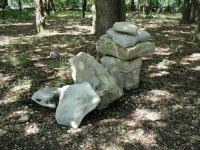
Few standing or legible headstones are present in the slave portion of the cemtery.
The odd thing about the slave section is that it now stands as one of the more peaceful and pleasant areas of the cemetery. The corner is completely covered by the heavy foliage of the trees here. No other part of the park is as shady. A few piles of rock scattered about and
an occassional headstone are the only clues that remain to indicate that people lay at rest here.
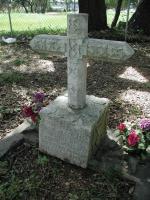
The hispanic section of the cemtery includes many stones in Spanish. Several of the stones, such as this intricately carved cross, are particularly interesting.
The ending of slavery did not end the practice of racial segregation, which exists today to an extent. Illustrating this point is the hispanic section of the cemetery that runs along the cemetery's southern boundary from its entrance to its western edge. One can sense the difference between this section and others before observing the family names on the markers. Though not necessarily larger, the graves are sometimes more elaborate and adorned with more flowers and momentos. The hispanic section features several markers that were carved
into large, intricate, standing crosses.
Many people decry a modern society that elevates the infamous to celebrity status, as though there was no distinction between famous and infamous. The fact of the matter is that this phenomena is not a recent development. The most famous person associated with Round Rock, a person for whom streets have been named and festivals held, was an outlaw. His name was Sam Bass.
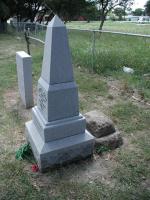
The new Sam Bass marker sits directly in front of the original, chipped tombstone.
Sam Bass staged most of his robberies of stage coaches and trains in Nebraska and north Texas. In 1878, with the Texas Rangers on his trail, Bass and a group of followers decided to head south to avoid capture. The decided on the town of Round Rock where they planned to rob a local
bank. With the help of a gang member informant Texas Rangers and area sheriffs were tipped to his plans and gathered to capture the group. Confronted at Kopperal's Store in Round Rock Bass and two accomplices shot it out with lawmen and local citizens. One gang member was killed
and Sam Bass was mortally wounded. He was later captured and passed away a couple of days later from his wounds.
Bass was buried in Round Rock Cemetery with little fanfare. It was not until a few years later that his sister erected a small tombstone at his grave. This marker has been chipped away by souvenir hunters over the years. A modern marker was placed at his grave immediately in front of the old marker, which can still be seen.
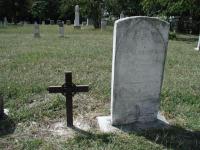
The final resting place of Deputy Sheriff A.W. Grimes, killed by the Bass gang in 1878.
One of the interesting things about the Round Rock Cemetery is that it provides the other side of the story. While Sam Bass and his gang were immortalized in song and memorials, little is remembered about one of the other people killed in the shootout at Kopperal's Store, the
lawman A.W. Grimes. Grimes was a former Texas Ranger who was serving as Deputy Williamson County Sheriff when the Bass gang came to town. Grimes noted that a member of the Bass gang was illegally brandishing a hand gun within city limits. At the time Grimes had no idea that the men he confronted were Bass and his gang. He asked whether they were carrying hand guns and they replied in the affirmative and opened fire on him, hitting him six times.
Grimes left behind a wife and three children. In order to assist in their needs following his death they received $200 and one of the Bass gang's horses as indemnity. Grimes' headstone lies almost on the opposite side of the cemetery from Sam Bass, about as far apart as could be
accomplished, which seems fitting. Grimes' headstone is the original. Recently an additional stone was placed with the story of Grimes' death. A small metal cross sits next to his grave with the insignia indicating his former involvement with the Texas Rangers.

The common "tree stump" Woodmen tombstone. The cemtery includes a wide variety of Woodmen Memorial designs.
Round Rock Cemetery has a large number of
Woodmen
of the World tombstones. This fraternal benefit order was organized in Nebraska in 1890 for the purpose of providing life insurance death benefits to its members. An optional rider to policies provided for a
Woodmen tombstone. There is a wide variety of Woodmen marker types on display here and it appears obvious that the organization had a strong following in the area in the early 20th century.
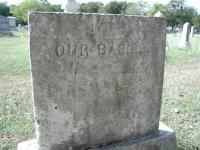
A marker for multiple children who died young.
Frontier life was tough. The mortality rate for children was very high and it's not uncommon to find family plots where a couple were buried next to several of their children who died before reaching adulthood. One of the more interesting stones we saw that fit this category was a marker that simply read "Our Babies". No names or dates are present. One is struck by the thought that the parents who erected the marker had lost, or expected to lose multiple children at an early age. This marker would serve its purpose no matter how much suffering they and their children would endure.
With so much history and so many stories that abound within its boundaries the Round Rock Cemetery is a must-stop spot for realizing a greater appreciation for the history of the Central Texas area. The history of 150 years ago can not be told by any remaining living individuals and sometimes the history books approach subjects from a stale, sterile angle. This cemetery, like many others, provide tangible stories to indicate the way things were. Not stories told by the living, but rather stories told by those who once lived.